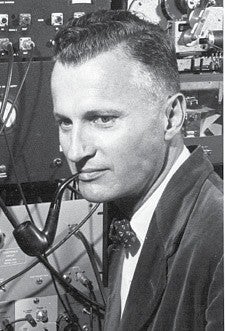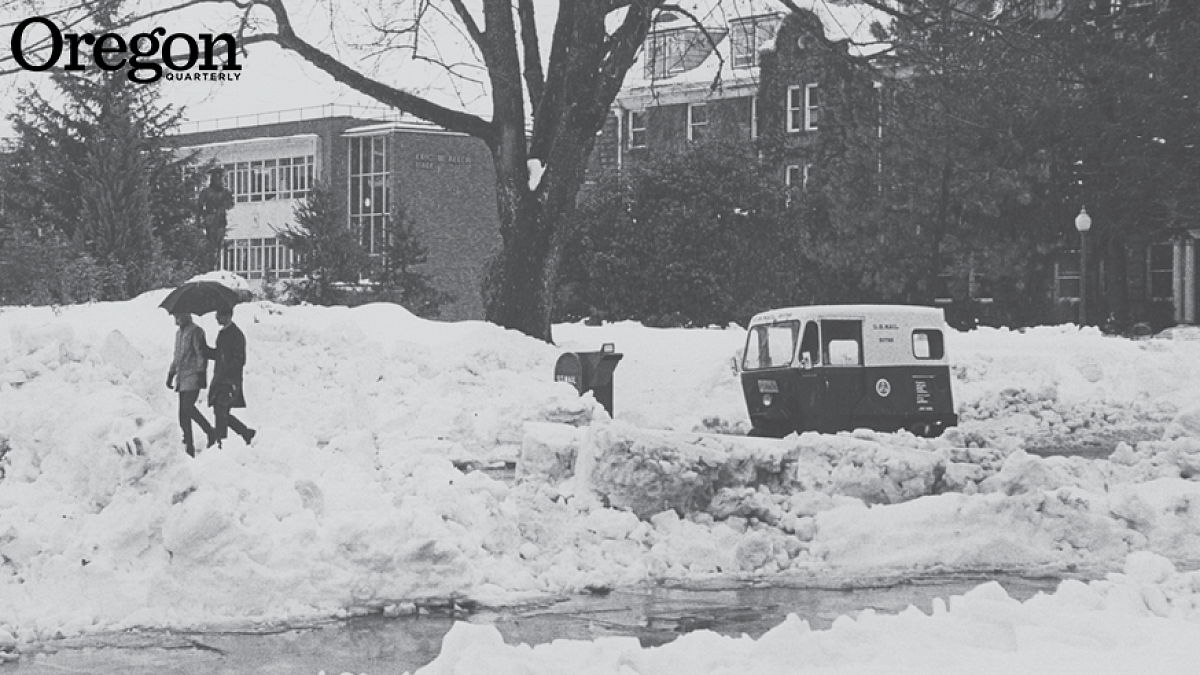Snow Day
Really, fifty years ago!!?? My, how time flies. I drove down from Portland with Brent, my fraternity brother (Phi Delta Theta) and good friend from our high school football days, in his manual-transmission, flesh-colored ’65 Mustang, barely beating the snow and closure of the freeways to the campus. Besides the onslaught of snow, I remember most earning good pay for shoveling snow off the roofs of buildings. It was a wet, heavy snow. Cold, yes. Tiring, yes. But great pay. I think it was 12 bucks an hour, which was a lot back then. Did we eventually build snowmen??? Don’t recall.
Steve Dossey, BS ’71 (psychology)
Santa Fe, New Mexico
Urban Streets
Recently, while visiting my son (Thomas, BS ’09) in Tacoma, I was pleasantly surprised to find a winter 2019 copy of Oregon Quarterly. I was particularly interested in page 25, “Walk of Life,” by Sarah Urban. Great writing! Even more interesting was the picture and caption on page 39, “Snowplace like home?” I was a struggling rhetoric and public affairs (now J-school) sophomore when that snowfall gave us all a few days off. It seems like yesterday, even though 50 years (!) have passed.
Dale Brieske, BS ’71 (speech: telecommunication and film)
Redmond, Oregon
I enjoyed Sarah Urban’s piece on walking the South University neighborhood. When I was living south of campus in the ’70s, I walked those streets—and the alleys between them—early on Sunday mornings. Usually the only signs of life were birds and cats. I don’t remember whether I mentally started or polished any writing on those peaceful strolls, but in the decades since I’ve certainly found walking to be a helpful part of a writing day.
Amy Houchen, BS ’74 (economics), JD ’78
Portland, Oregon
Sinister Laboratory
Professor Benjamin Aleman created a cloaked insider joke as his lab logo (“Quantum Navigator,” Winter 2018, and above) but it is easily deciphered. Add an upward extension to the end bracket of the ket symbol and we have the explanation for the disappearance of Alaby Blivet from the class notes. He was kidnapped to be subjected to physics experiments! Is there also a Sara Lee lab? No science ethics committee?
Ariel Friesner, BA ’81 (English)
Eugene, Oregon
Remembering Professor Crasemann

 I would like to congratulate you on your magazine. I was terribly saddened to read of Bernd Crasemann’s passing (winter 2019). I was a student in his physics class, which had five women, as I recall, and 90 guys. When I went to the UO to get an application for medical school, the lady at the desk told me, “You do not need to apply as they are not going to take any women this year.” That was 1958! The five of us since have all worked in science and have made significant contributions as chemists, professors, and nurses, and one finally got into med school several years later at Northwestern University. The five of us all kept in touch with Bernd Crasemann for years, as he was our favorite professor and not by a little bit. Several years later, I received a card in the mail from him congratulating me on winning a ski race. On the front was a picture of the Stanford U linear accelerator and a note on the back that read, “Shirley, I hope you used your physics in your ski racing.” I wrote back to him and thanked him for his great generosity and mentioned to him that I used his alternating current experiment every day of my life. Rest in peace, Professor Crasemann.
I would like to congratulate you on your magazine. I was terribly saddened to read of Bernd Crasemann’s passing (winter 2019). I was a student in his physics class, which had five women, as I recall, and 90 guys. When I went to the UO to get an application for medical school, the lady at the desk told me, “You do not need to apply as they are not going to take any women this year.” That was 1958! The five of us since have all worked in science and have made significant contributions as chemists, professors, and nurses, and one finally got into med school several years later at Northwestern University. The five of us all kept in touch with Bernd Crasemann for years, as he was our favorite professor and not by a little bit. Several years later, I received a card in the mail from him congratulating me on winning a ski race. On the front was a picture of the Stanford U linear accelerator and a note on the back that read, “Shirley, I hope you used your physics in your ski racing.” I wrote back to him and thanked him for his great generosity and mentioned to him that I used his alternating current experiment every day of my life. Rest in peace, Professor Crasemann.
Shirley Parmenter Tallackson, BA ’58 (general science)
Sun Valley, Idaho
Atkeson Moonlighting?
In the great photo book by Warren Miller and Ray Atkeson, Ski and Snow Country: The Golden Years of Skiing in the West, 1930s–1950s, my friend Warren noted that Ray did most of his photography on weekends while holding down his Monday–Friday job as a freight elevator operator at Montgomery Ward.
Tom Levak, BA ’61 (political science)
Portland, Oregon
Wolf Questions
I would be interested in seeing a couple facts checked by the students in their wolf study (“Tracking Conflict and the Wolf,” Winter 2019). What species of wolf was OR4? What species of wolf is indigenous to Oregon? What species currently inhabit the state? Are they the same? If not, how do their attributes and demeanor differ? The introduction to the study is quoted saying that we have 125 confirmed wolves in the state. How does the state come to that number? Does the state’s method of counting leave room for a larger population to potentially inhabit Oregon? What is the inflection point on the number of wolves that begin impacting all other wildlife population? Lastly, in most of the states where wolves can be found, they have populations of other animals for food, like moose, caribou, grizzly bear, etc. How are areas that don’t have these other animals as food sources impacted differently than the areas that do (Oregon, for example)? Thanks for your consideration and look forward to reading about this study at its conclusion.
Casey Hunt, BS ’04 (sociology)
Pendleton, Oregon


